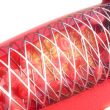Much has been done since studies on conventional balloon angioplasty for BMS instent restenosis showed over 40% new revascularization. Drug eluting stents, aimed at improving this problem, have never achieved 0% restenosis, which is why technologies such as paclitaxel coated balloons have been developed, with reasonable efficacy (8% to 10% reinterventions rate for BMS restenosis and 17% to 23%...
Success in CTOs caused by restenosis lowers cardiac mortality
Courtesy of Dr. Carlos Fava. Nowadays, chronic total occlusions (CTO) due to in-stent restenosis (ISR) represent 5%-25% of all coronary angioplasties. These lesions pose a new and true challenge, since CTOs are often associated with stent-related problems (fractures, lack of expansion, overlapping, deformation), extreme tortuosity, severe calcification, tandem lesions after CTO, and aorto-ostial lesions, with little...
Instent restenosis: Drug eluting balloons or drug eluting stents?
Original Title: Long-Term Results of Everolimus-Eluting Stents versus Drug-Eluting Balloons in Patients with Bare-Metal In-Stent Restenosis 3-Year Follow-Up of the RIBS V Clinical Trial. Reference: Alfonso F. et al. JACC Cardiovasc Interv. 2016 Jun 27;9(12):1246-55. Courtesy of Dr. Agustín Vecchia. RIBS V 3 year follow up Stents have become the gold standard for...
Is the 2nd generation DES an alternative to surgery in multivessel coronary disease?
The benefits of 2nd generation drug-eluting stents (DES) are being compared with Coronary artery bypass graft surgery (CABG), looking to achieve a safe, effective, less invasive and as complete as possible revascularization. As background of SYNTAX, the stent thrombosis (ST) with Taxus, reached 25% of the events in the group of intervention (PCI), so that...
Double Anti platelet aggregation would be sufficient for six months after angioplasty in patients with stable coronary disease NSTSEACS.
Original title: 6- Versus 24-Month Dual Antiplatelet Therapy After Implantation of Drug. Reference: Eluting Stents in Patients Nonresistant to Aspirin The Randomized, Multicenter ITALIC Trial. JACC.VOL. 65, NO. 8, 2015 Current recommendations on dual antiplatelet therapy (DAPT) are under review, particularly in acute coronary events due largely to the advent of second-generation stents. This work studied the hypothesis...
- 1
- 2




